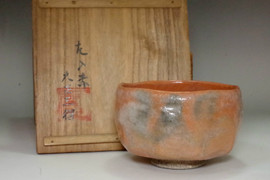Raku 6th Sanyu (1685-1739) Antique kuro-raku tea bowl #4308
- SKU:
- 4308
- Shipping:
- Free Shipping
- width: approx. 9.6cm (3 25⁄32in)
- height: approx. 7cm (2 3⁄4in)
- weight: 257g (w/ box 377g)
- condition: fixed (no water leaked) The bowl wobbles a little when it stands.
Raku 6th Sanyu 1685-1739
Born as the second son of Odaya Kahei, he became the son-in-law of Sonyu. His original name was Sokichi, and he was later renamed Yoshiakira. His family home was in a town called Nijo Higashiiri, in Ajikoji, Kyoto Prefecture. It is still unknown when exactly he joined the Raku family as well as his specific relations with them. In 1708, as Sonyu retired, Yoshiakira married Sonyu’s daughter Myoshu, and took over the highly esteemed position as 6th generation Kichizaemon (tea bowl artisan).
In 1728, Yoshiakira retired at age 44, passing on the Omotensenke 6th generation tea ceremony school to his eldest son, Sanyu. At the time, Sanyu was only 15 years old. Yoshiakira produced many works in retirement, and in 1728 he handmade his 50th bowl, the “Ryuhou 50th”. Shortly after in 1733, he produced a series of bowls he called the “Sanyu 200”, which is said to be an ode to Sanyu. This series consists of 200 red and black bowls, each one bearing has its own individual features. Each tea bowl has been named by the 7th generation Omotensenke school, and all of which are prized among tea masters. The engraving on each cup has been recorded, and is still visible to this day.
Sanyu studied the work from the famous Raku family bowls, and also those of Koetsu and Setoguro. This is supported by Sanyu’s own rational approach and excellent workmanship, such as his use of the spatula to form the shape of the bowls in the style of the calligrapher and craftsman Koetsu, which can be seen in his Amagumo (rain cloud) collection within the museum.
Sanyu is renowned for his ability to create a new, fresh, unrestricted style of pottery that not only positively explored the disadvantages within the Raku family traditions, but also incorporates aspects from his different upbringing.
In general, Sanyu’s bowls have very unique and distinctive characteristics in the engraving on the base of the bowl, for example, a bold spatula mark or finer etchings. Sanyu’s black glaze bowls had a more rigid style, and some also had a slight blue tinge, others were well fused some had a glossy finish; similar to that of the skin of the citrus fruit Yuzu.
Many of the red bowls have an opaque, cloudy glaze to them, and there are also many with a soft, gentle appearance. There are also bowls on which small sketches have been drawn with a faint brush stroke, which may be one of the new aspects that never existed before.

















